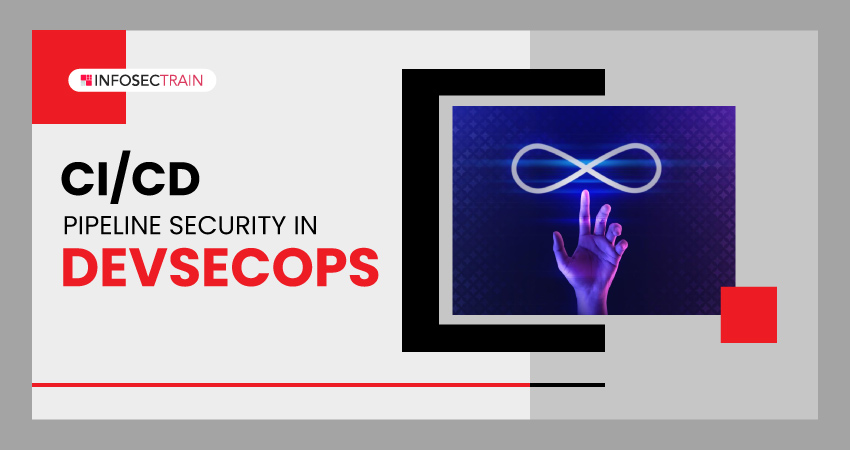CI/CD Pipeline Security in DevSecOps
A vital component of the DevSecOps concept is CI/CD pipeline security, which enables organizations to develop and release software while maintaining high security swiftly. Organizations can detect and fix vulnerabilities early in the development process by incorporating security measures into the pipeline, lowering the chance of security breaches. Some of the best practices organizations may use to increase the security of their CI/CD pipelines and build a more secure software delivery pipeline in the DevSecOps era include access control, automated testing, and secret management. Security in DevSecOps is not a gatekeeper but a facilitator of quick, secure software delivery.

Table of Contents
What is CI/CD Pipeline Security?
DevSecOps as a System
The Importance of CI/CD Pipeline Security
Common Tools and Techniques for CI/CD Pipeline Security
Best Practices for CI/CD Pipeline Security
What is CI/CD Pipeline Security?
Continuous Integration and Continuous Deployment pipeline security secures the CI/CD pipeline, a vital part of contemporary software development. Security controls and checks must be implemented at every level of the pipeline, from code development and integration through automated testing and deployment. Early vulnerability and threat detection and mitigation are intended to lower the risk of production-level security breaches. Following the DevSecOps principles, CI/CD Pipeline Security and the shift left approach ensures that software upgrades are provided quickly and with a strong focus on security.
DevSecOps as a System
A cultural and practical shift in the software development life cycle is represented by the term DevSecOps, a combination of development, security, and operations. It aims to make security checks and measures a fundamental component of the development process rather than a distinct stage by seamlessly integrating security into the CI/CD pipeline. DevSecOps attempts to do this to find security flaws early in the development cycle and fix them, lowering the possibility of production security breaches.
The Importance of CI/CD Pipeline Security
- Vulnerability Scanning: Continuous integration and deployment have the potential to make the software vulnerable. Security scans can be incorporated into the pipeline to help teams find and fix vulnerabilities before they are used in production, which reduces the area that can be attacked.
- Rapid Response: A well-secured CI/CD pipeline enables teams to respond quickly in the event of a security issue, assisting them in doing so quickly and with the most minor damage possible. Flexibility in responding to security events is essential to avoid any harm and minimize any delays in the software delivery process.
- Shift-Left Security: Security practices should be shifted left in the development process, according to DevSecOps. Security issues must be addressed immediately, even before the code is submitted. CI/CD pipeline security can identify problems early on by allowing automated testing and security checks during code integration.
Common Tools and Techniques for CI/CD Pipeline Security
- Static Application Security Testing (SAST): SAST tools look for potential security flaws by statically inspecting code (without running it). They assist developers in identifying defects that could result in SQL injection attacks or cross-site scripting vulnerabilities early in the development process, enabling quick repairs before release.
- Dynamic Application Security Testing (DAST): DAST tools interact with a program while running, simulating actual attacks to find vulnerabilities. This method ensures a more thorough evaluation of application security by assisting in discovering vulnerabilities that might not be obvious through static analysis alone.
- Container Image Scanning: Container image scanning involves inspecting the contents of container images for security weaknesses. These tools analyze image components like libraries and dependencies to identify known vulnerabilities. This proactive approach ensures that containers deployed in production are free from known security risks, enhancing overall system security.
- Secret Management: Secret management tools are designed to securely handle and store confidential data within an organization. They ensure that critical secrets, such as login credentials or API keys, are stored and accessed in a protected manner. This safeguards sensitive information from unauthorized access, minimizing security risks associated with secret mishandling.
- Infrastructure as Code (IaC) Scanning: IaC scanning entails looking over templates for infrastructure code, like those written in YAML or JSON, to find security flaws. These solutions ensure that the code used to provide and configure cloud resources and infrastructure is secure, lowering the possibility of incorrect configurations or security flaws. It aids in maintaining a dependable and safe cloud environment.
Best Practices for CI/CD Pipeline Security
- Implement Automated Security Checks: By automating security tests, you create a regular and organized process for scanning code and configurations for potential security flaws. The window of exposure to security threats is reduced due to this proactive approach’s assurance that security evaluations are carried out consistently at every pipeline level, enabling quick response.
- Pipeline Monitoring: Continuous CI/CD pipeline monitoring is essential to detect abnormal activity or potential security breaches. This practice helps identify security issues or unauthorized access in their early stages, enabling swift responses and mitigating risks to the pipeline and the deployed software.
- Promptly Address Security Incidents: It’s critical to respond immediately when a security flaw or vulnerability is found. Taking action quickly can help control the problem, lessen possible damage, and stop additional exploitation. This proactive strategy effectively addresses security events, reducing the impact on your CI/CD pipeline and the software it produces.
- Integrate Security Into Your Development Process: Assuring that security considerations are incorporated into each stage of development starts with embedding security from the beginning. This proactive integration lessens the possibility that vulnerabilities may appear in the finished product by assisting in the early detection and remediation of potential security problems. It urges the development team to prioritize security.
- Educate Your Team: It’s crucial to spread knowledge and awareness about CI/CD pipeline security. Your team gains the knowledge necessary to implement security measures and better understand potential risks efficiently. A knowledgeable team is better prepared to proactively address security issues, increasing the overall security of the development process.
About InfosecTrain
InfosecTrain is a leading IT security training and consulting services provider, offering tailored and affordable training for businesses and individuals worldwide. Our role-specific certification programs, such as the Certified DevSecOps Engineer (E|CDE) course, are designed to prepare professionals for the future by instilling DevSecOps principles. This training equips you with essential skills to create, implement, and maintain secure applications and infrastructure. Invest in your career with our flexible and comprehensive DevSecOps Engineer program, backed by our unwavering support at every stage. We’re committed to helping you thrive in the ever-evolving DevSecOps landscape.




 1800-843-7890 (India)
1800-843-7890 (India) 
